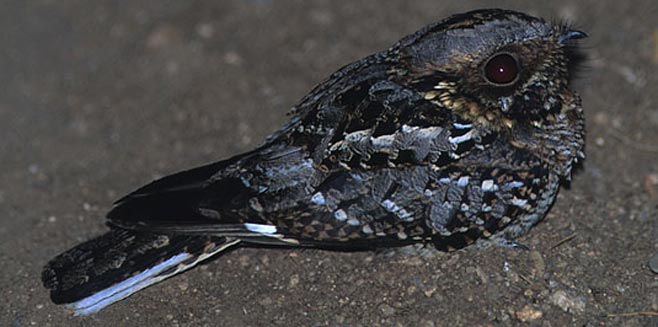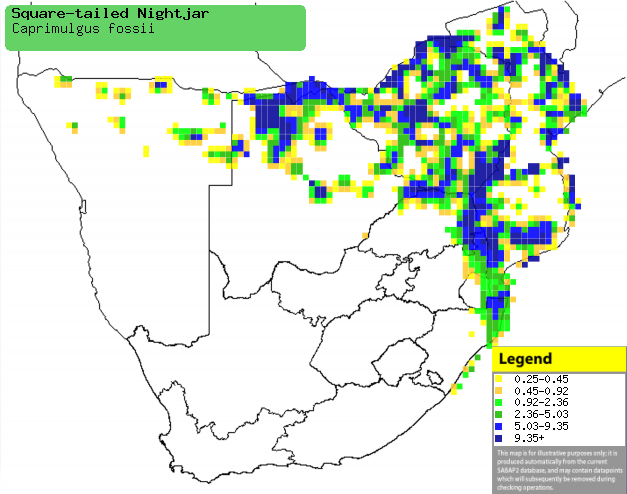|
Caprimulgus fossii (Square-tailed
nightjar, Mozambique nightjar)
Laeveldnaguil [Afrikaans]; Datiwa (generic name for
nightjar) [Shona]; Malwelwe (generic term for nightjar) [Swazi]; Kubhasti
(generic term for nightjar) [Tsonga]; Gabonnachtzwaluw [Dutch]; Engoulevent du
Mozambique [French]; Gabunnachtschwalbe [German]; Noitibó de Moçambique
[Portuguese]
Life
> Eukaryotes >
Opisthokonta
> Metazoa (animals) >
Bilateria >
Deuterostomia > Chordata >
Craniata > Vertebrata (vertebrates) > Gnathostomata (jawed
vertebrates) > Teleostomi (teleost fish) > Osteichthyes (bony fish) > Class:
Sarcopterygii (lobe-finned
fish) > Stegocephalia (terrestrial
vertebrates) > Tetrapoda
(four-legged vertebrates) > Reptiliomorpha > Amniota >
Reptilia (reptiles) >
Romeriida > Diapsida > Archosauromorpha > Archosauria >
Dinosauria
(dinosaurs) > Saurischia > Theropoda (bipedal predatory dinosaurs) >
Coelurosauria > Maniraptora > Aves
(birds) > Order: Strigiformes > Family: Caprimulgidae
 |
|
Square-tailed nightjar, Ingwelala Nature Reserve,
Limpopo Province, South Africa. [photo
Lizet Grobbelaar ©] |
The Square-tailed nightjar is occurs across Africa south of
the Sahel semi-desert, preferring open areas with sandy soil, such as Acacia
savanna, miombo woodland, etc. It is insectivorous, feeding mainly on
beetles, grasshoppers and moths. It mainly hunts just after sunset, searching
for prey from a low perch, then hawking any insect that passes by. It nests in
shallow, natural depressions in sandy soil or fine gravel, usually in bare, open
areas with little vegetation, such as cultivated fields. It lays 1-2, usually 2
eggs, which are incubated mainly by the female for about 14-17 days. The chicks
can walk around soon after hatching, becoming fully independent after a month or
two of parental care.
Distribution and habitat
Occurs across Africa south of
the Sahel, from the DRC through to southern Africa. Here it is
common in north-eastern Namibia (including the Caprivi Strip), northern and
eastern Botswana, Zimbabwe, Mozambique and eastern South Africa. It generally
prefers open areas with coarse sand and bush, such as
Acacia savanna, miombo woodland and dune scrub, as it requires lots of
open sand for nesting and roosting.
|
 |
|
Distribution of Square-tailed nightjar in southern Africa,
based on statistical smoothing of the records from first SA Bird Atlas
Project (©
Animal Demography unit, University of
Cape Town; smoothing by Birgit Erni and Francesca Little). Colours range
from dark blue (most common) through to yellow (least common).
See here for the latest distribution
from the SABAP2. |
Predators and parasites
- Predators
- birds
- mammals
- mongooses
- Crocodylus niloticus (Nile crocodile)
Food
It is insectivorous, feeding mainly
on beetles, grasshoppers and moths. It typically hunts just after sunset, searching
for prey from a low perch, then hawking any insect that passes by. It also
forages around electric lights and campfires, feeding on any insects attracted
to them. The following food items have been recorded in its diet:
Breeding
- It nests in shallow, natural depressions in sandy
soil or fine gravel, usually in bare, open areas with scarce vegetation,
such as cultivated fields.
- Egg-laying season is from September-December.
- It lays 1-2, usually two eggs, which are incubated mainly by the female
for about 14-17 days.
- The chicks can walk around soon after hatching, becoming fully
independent after a month or two of parental care.
Threats
Not threatened, in fact widespread and common.
References
-
Hockey PAR, Dean WRJ and Ryan PG (eds) 2005. Roberts
- Birds of southern Africa, VIIth ed. The Trustees of the John Voelcker
Bird Book Fund, Cape Town.
|
